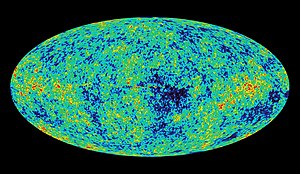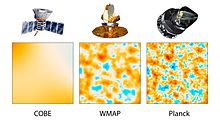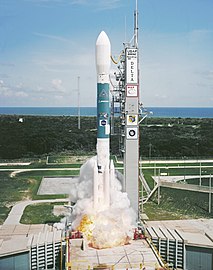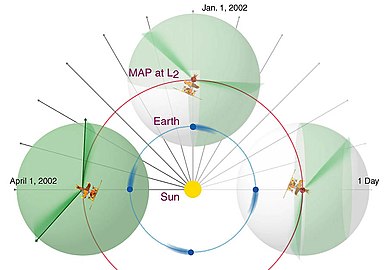WMAP
The Wilkinson Microwave Anisotropy Probe or WMAP is a NASA probe whose mission was to study the sky and measure the temperature differences observed in the background radiation microwave, a remnant of the Big Bang. It was launched by a Delta II rocket on June 30, 2001 from Cape Canaveral, Florida, United States.
The objective of the WMAP mission was to test theories about the origin and evolution of the universe. This mission was the successor to the Cosmic Background Explorer (COBE) and is part of NASA's medium-class explorer program.
WMAP was named in honor of David Wilkinson, a member of the mission's science team and a pioneer in the study of background radiation. The scientific objectives of the mission are that the temperature of the cosmic microwave background must be measured with very high resolution and sensitivity. Because of this, the greatest emphasis in the design was to avoid systemic errors in data collection.
The WMAP probe uses differential microwave radiometers that measure temperature differences between any two points in the sky. WMAP is in orbit around the Lagrangian point L2, located about 1.5 million kilometers from Earth.

This observation point (located on the line joining the sun and the earth) provided the probe with an exceptionally stable environment, since it can point in any direction into deep space, without being affected by the presence of the parent star.. In addition, from point L2 the probe observes the entire sky every six months. To avoid interference from our own galaxy, WMAP used five separate frequency bands, from 22 GHz to 90 GHz.

On February 11, 2003, NASA's public relations group called a press conference to communicate the age and composition of the universe based on data from the WMAP probe. At this press conference the most intricate image of the early universe taken to date, until the results of the Planck artificial satellite. According to NASA, this image "contains such a level of detail that it can be considered one of the most important scientific results in recent years." It must be taken into account that although this image is not the highest resolution taken of the cosmic microwave background, it was at the time the best image we have of the background radiation of the entire sky.
The three-year WMAP data was released on March 17, 2006. These data include measurements of CMB temperature and polarization, which provide stronger confirmation of the standard Lambda-CDM model. Later, in 2008, the 5-year data were published, in 2010 the 7-year data and in 2012 the 9-year data.
Discoveries made with the WMAP probe


WMAP obtained measurements of many cosmological parameters with much greater precision than we had until then. Consistent with then-models of the universe, the WMAP data showed that:
- The age of the universe is 13.700 ± 200 million years.
- The universe is composed of 4% of ordinary matter, 23% of dark matter and 73% of the mysterious dark energy.
- Inflationary cosmological models are verified with observations, although there is an inexplicated anomaly at large angular scales.
- Hubble Constant is 70 (km/s)/Mpc, +2.4/-3.2
- WMAP data confirm, with only 0.5% error margin, that the shape of the universe is flat.
- The cosmological panoramas of cosmic inflation are in a better agreement with the data of three years, although there is still an inexplicated anomaly to the larger angular measure of the quadrupolar moment.
Other instruments also focused on measuring the cosmic microwave background
Prior to WMAP
Before WMAP, several instruments improved our maps of the cosmic microwave background:
- COBE Cosmic Fund Explorer: measured large-scale fluctuations, with little resolution
- Cosmic Anisotropy Telescope: measured small scale variations in specific areas of the sky
- BOOMERanG: measured fluctuations with improved precision
- Maxima: measured fluctuations with improved precision
- Cosmic Background Imager: measured small-scale fluctuations with improved precision
After WMAP
Instruments that have made measurements with greater precision and resolution than the WMAP:
- Planck artificial satellite

Monitoring missions and future measurements

The original schedule for the WMAP consisted of two years of observations. These were completed in September 2003. Mission extensions were granted in 2002, 2004, 2006 and 2008, giving the spacecraft a total of 9 years of observation, which ended in August 2010 and in October 2010 the spacecraft Space was moved to a heliocentric orbit, a graveyard orbit.
The Planck spacecraft also measured background radiation from 2009 to 2013 and aims to refine the measurements made by WMAP, both in total intensity and polarization. Several ground-based and balloon-based instruments have also made contributions on the CMB background radiation, and others are being built to do so. Many are aimed at finding the B-mode polarization expected from the simplest inflation models, including the E and B experiment (EBEX), the Spider polarimeter, the BICEP and Keck Array (BICEP2), the Keck Array, the QUIET, the Cosmology Large Angular Scale Surveyor (CLASS), the South Pole Telescope (SPTpol) and others.
On March 21, 2013, the European-led research team on the Planck spacecraft published the mission's map of the cosmic microwave background. The map suggests that the universe is a little older than we thought. was previously thought. According to the map, subtle temperature fluctuations were imprinted on the deep sky when the cosmos was about 370,000 years old. The imprint reflects waves that arose as early as the first ninety-millionth (10−30) part of a second in the existence of the universe. Apparently, these waves gave rise to the current vast observable Universe of galactic clumps and dark matter. Based on 2013 data, the universe contains 4.9% ordinary matter, 26.8% dark matter, and 68.3% dark energy. On February 5, 2015, new data were published by the Planck mission, according to which the age of the universe is 13,799 (± 0.021) million years and the Hubble constant was measured at 67.74 ± 0.46 (km/s)/Mpc.
Launch, trajectory and orbit
The WMAP spacecraft arrived at the Kennedy Space Center on April 20, 2001. After being tested for two months, it was launched via a Delta II 7425 launch vehicle on June 30, 2001. It began began operating on its internal power five minutes before launch, and continued operating until the solar array was deployed. The WMAP was activated and monitored while it cooled. On July 2, 2001, it began work, first with flight tests (from launch to August 17, 2001), then began working steadily and formally. Afterwards, it performed three Earth-Moon phase loops, measuring its sidelobes and then flew by the Moon on July 30, 2001, en route to the Sun-Earth Lagrange point L2, arriving there on October 1, 2001, becoming the first CMB observation mission.
WMAP launch from the Kennedy Space Center on 30 June 2001
WMAP Trayectoria and orbit
Orbit and strategy to examine the sky of WMAP
Probe description

The telescope's primary reflecting mirrors were a pair of 1.6 m Gregorian telescopes, which focus the signal onto a pair of secondary reflecting mirrors. They are molded for optimal performance: a carbon fiber shell over a Korex core, coated with aluminum and silicon oxide. The secondary reflectors transmit the signals to corrugated feed horns which are located in an array box with the focal plane below the primary reflectors.
The receivers are sensitive differential polarization radiometers that measure the difference between two telescope beams. The signal is amplified with a high electro-mobility transistor (HEMT), a low-noise amplifier built by the National Radio Astronomy Observatory (NRAO), USA. The azimuth directional separation is 180°; The total angle is 141º. To improve the removal of foreground signals from our Milky Way galaxy, WMAP used five discrete radio frequency bands, from 23 GHz to 94 GHz.
The base of WMAP is a 5 m diameter array, a solar panel that keeps the instruments in shadow during CMB observations, (keeping the spacecraft constantly at an angle at 22º, relative to the Sun). On this base sits a lower cover (which supports the warm components) and an upper cover. The cold components of the telescope are the focal plane array and the mirrors, they are separated from the warm components with a 33 cm long cylindrical casing.
Passive thermal radiators cool the WMAP to approximately 90 K. They are connected to the low noise amplifiers. The telescope consumes 419 W of power. The telescope heaters available are emergency-survival heaters, and there is a transmitter heater, which is used to heat them when they are turned off. The temperature of the WMAP spacecraft is monitored with platinum resistance thermometers.
WMAP calibration is carried out with the CMB dipole and Jupiter measurements. Beam patterns are measured against Jupiter. Data from the telescope were transmitted daily via a 2 Ghz transponder providing a 667 kbit/s downlink to a station 70 m away on the NASA Deep Space Network. The spacecraft has two transponders, one of them a redundant backup; They are minimally active (about 40 minutes daily) to minimize radio frequency interference. The telescope's position is maintained, on its three axes, with three reaction wheels, gyroscopes, two star trackers and a sun sensor, and it was steered with eight hydrazine thrusters.
Development
The MAP mission was proposed to NASA in 1995, selected for definition study in 1996, and approved for development in 1997.
WMAP was preceded by two CMB observation missions; (i) the Soviet Relikt-1 that reported measurements of the upper limit of CMB anisotropies, and (ii) the American Cosmic Background Explorer COBE satellite that reported large-scale CMB fluctuations for the first time. WMAP was 45 times more sensitive, with 33 times the angular resolution of its COBE satellite predecessor. The European Planck successor mission (operational 2009-2013) had higher resolution and greater sensitivity than WMAP and was observed in 9 frequency bands instead of WMAP's 5, which allowed for improved foreground astrophysical models.
Contenido relacionado
Atlas (rocket)
Geostationary transfer orbit
Exploration of mars
Astronautics
Annex: American interplanetary probes




